Many times I look at cars that are claimed to be rare by their sellers and wonder how rare is “rare.” Not this time – this is one of only sixteen Grand Prix Super Duty cars produced in 1962, as documented by this list. It’s listed for sale here on eBay where bidding is rapidly approaching $30,000 and I suspect it will go much higher. The car is located in Troy, Michigan.
Super Duty. Two words that will thrill most Pontiac fans. At one point in time, according to this article, it was believed that the 1962 421 Super Duty engine, essentially a drag racing engine in a street car, was only installed in Catalinas. As it turns out, 16 Grand Prixs were produced with the behemoth of an engine as well. This car, a genuine unrestored find, is in completely as-found condition. Unfortunately, that means that it is without it’s original engine. More about that later. In the meantime, look at those great 8-lug wheels!
There doesn’t appear to be a lot of rust, and the seller reports largely original paint apart from some previous accident damage on the right front fender and where a tree limb fell on the right rear quarter panel. There’s some rust scale on the underside, but it doesn’t look too bad.
On the bright side, the interior doesn’t look like it’s been messed with. On the not so bright side, it doesn’t look like it’s been maintained, either. I suspect given the rarity of the car whomever ends up with it will want to make it perfect. By the way, yes, that is a factory four-speed transmission — remember, this car was made for the drag strip! With only 49,176 original miles you’d think it would have it’s original engine, but you’d be wrong.
Here’s the hole where the engine should go. The seller reports that unfortunately the original engine no longer exists, or at least it’s not with the car. However, someone has gone to the trouble to source an original 421 Super Duty block, and they have also found an original aluminum dual quad intake, original heads, and the very rare factory high performance exhaust manifolds.
Here’s the block. What do you think about the idea of the replacement block? Personally, I don’t see it any differently than if the original owner had blown the engine at the drag strip (which might have actually happened!) and replaced the engine with a same year Super Duty–i.e. I don’t see any problems with it. How about you?





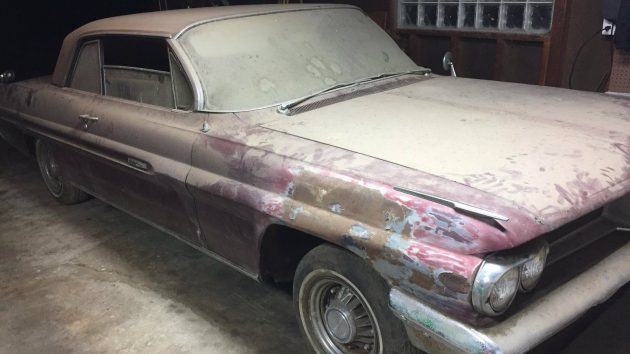
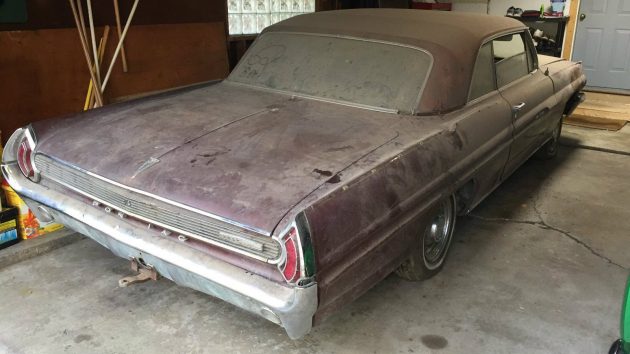
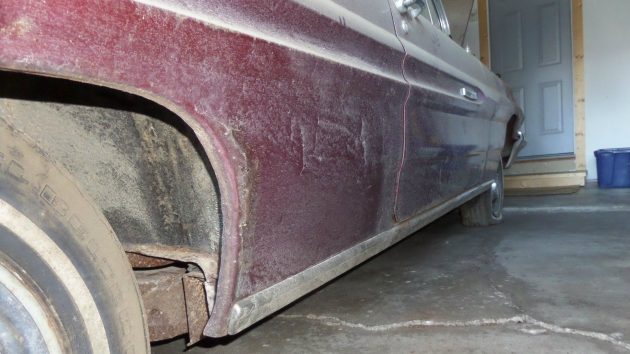
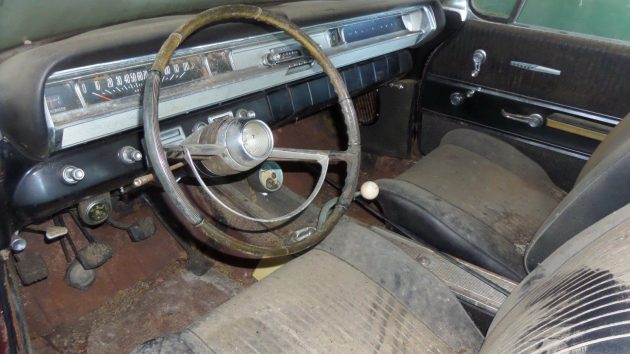

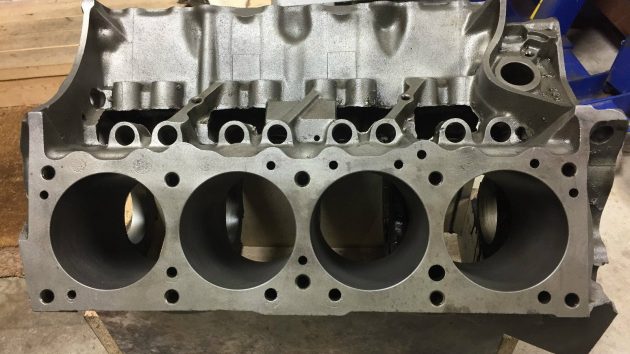
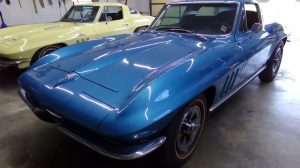
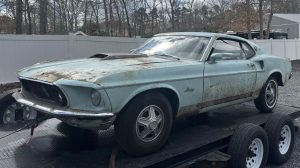




That’s a find worth a proper restoration… set the tone for the next decade of automotive enthusiasm. Very cool car.
@Andre – I respectfully disagree with you. That looks like it may be the original paint. If it is, then the best route for this ‘pearl of great price’, is to thoroughly clean every part, make whatever efforts do the least damage in treating the (very limited) rust, then re-assemble as nearly as possible to the ‘way it was’.
I am far less offended by a somewhat rusted wheel well (or sympathetic repair), than by a ‘better than new’ complete re-manufacture. The wheel well rust can be repaired on just the affected area, and you have left the car more-or-less as driven. (Yes, the repair will show in some lights, but so what?)
To me, these cars are like catcher’s mitts. When they are brand-new, they are only a good starting point. What impresses me, is one that is broken in and sorted. Not some immaculate Frankenstein, that exists all year under a 3-layer cover in a heated garage, only to be wheeled out for its annual showing.
Nice car. Nice find. This car is definitely worthy of a restoration!
I wish I had found it in my barn, it wouldn’t be for sale !
Right front fender where the paint is ground off….looks like rust ? Back in the day a friend had a ’62 Ventura SD. All sheet metal forward of firewall was aluminum ?
I like that hitch. But thought that the SD’ s had aluminum front ends ?
I believe some of the Catalinas did, and some had the “Swiss cheese” frames. I seem to recall that the GPs were thought to be all steel, but my thing isn’t GPs or SD cars, but later A-bodies(especially the ’70-’72 GTO) so I’m sure someone else may know for sure.
Not all SD cars had the aluminum. Some of the Cats were all steel and all of the GP SD cars were steel.
Not all SD cars had the aluminum. Some of the Cats were all steel and all of the GP SD cars were steel.
What did the super duty engine have as far as 4 bolt mains, bore and stroke, compression ratio, horsepower and torque. What type cam and lifters. Everyone wants a SD engine or an engine with the similar characteristics. Thanks Dave Burock
dave, found this online on the hot rod network page……
From an article in hot rod network 4 sept 2007
http://www.hotrod.com/articles/hppp-0704-1962-pontiac-catalina-421-super-duty/
The 421 Super Duty
Pontiac’s 421 Super-Duty engine debuted late in the ’61 model year as a larger version of the SD 389. Neither engine, however, was factory installed. Instead, the components were shipped to factory-backed racers for post-delivery installation, and the Super-Duty program’s overwhelming success forced racing organizations to limit engine eligibility to factory-installed units. Pontiac countered by offering the SD 421 as a regular-production option on ’62 Catalina and Grand Prix models.
The 389 and 421 Super-Duty packages were engineered for maximum performance, but the larger mill often overshadowed its smaller brethren. It featured a four-bolt block containing a 4.09-inch bore and a No. 542990 forged-steel crankshaft with a 4.00-inch stroke and 3.25-inch diameter main journals. The cylinders were filled with Mickey Thompson forged-aluminum pistons and No. 529238 forged-steel connecting rods. Its flat-tappet, mechanical camshaft was the newly designed No. 541596 McKellar No. 10 with 308/320 degrees of duration and 0.445/0.447-inch lift with 1.65:1-ratio rocker arms.
Two cylinder-head castings were used during the ’62 model year, both with a combustion chamber volume of 68 cc to produce an 11.0:1 compression ratio. Casting No. 540306 featured 1.92/1.66-inch valves and was carried over from the previous model year. It was used into March 1962 before casting No. 544127 with larger 2.02/1.76-inch valves entered production. Since both heads were designed for competition, neither was equipped with an exhaust crossover.
A cast-aluminum intake manifold housed two Carter four-barrel carburetors, and like the cylinder heads, a few different manifolds were used in ’62. Functionally the same, early model-year engines with No. 306 heads received casting No. 542991, while late-year engines with No. 127 heads utilized No. 9770319. Strangely, both contained an exhaust crossover though the cylinder heads did not. One last casting, No. 9770859, was available towards the end of the model year and had no exhaust crossover whatsoever.
Pontiac engineers designed a pair of highly efficient, cast-iron exhaust manifolds for the Super-Duty package. The units boasted separate bolt-on collectors that contained cutouts to bypass the 2.25-inch dual-exhaust system and low-restriction mufflers. This engine also received a specific harmonic balancer, oil pan, and fuel and oil pumps. A conservative gross rating of 405 hp at 5,600 rpm and 425 lb-ft of torque at 4,400 rpm was the end result.
The bulletproof engine was mated to a heavy-duty clutch and pressure-plate assembly and backed by a heavy-duty three-speed manual or a Borg-Warner T10 four-speed manual transmission in the Catalina, but only the four-speed in the Grand Prix. Though a limited-slip differential was optional, 4.30:1 was the only axle ratio available. Total documented production for Catalina and Grand Prix models equipped with the 421-SD is 155 and 16 units, respectively.
cant answer all that but sd combustion chambers were all HAND FINISHED. wow
This is one of the early muscle cars that is pivotal in the ignition and development of American high performance. Its value probably can not be overstated. It strongly evokes Mickey Thompson. Will need time to catch my breath.
well if this is real i would give my left nut to own it.
grew up in metro detroit and my guess is that i have been within 5 miles of this car several times in my life.
with the engine gone how does the seller know it is an original sd421 gp? my guess is that the only way to know for certain is if the trans is stamped on the top with the vin. there is a 926P10457 shown upside down in a picture. hopefully that is on the transmission. color codes match. but as frank mentioned above my understanding is that all the sd cars came with aluminum front clips. at least the catalinas. maybe gp’s were different?
as far as the missing engine and the replacement…..not having the original engine will bring the price down – no doubt. however, having a replacement engine from the same year, including heads and both intake and exhaust manifolds is a huge plus. when finished this car will look just as it would have upon delivery in mid-1962. the only thing better would have been to replace the block with a new one but keep the same heads, carbs, intake, etc from the original engine.
what’s the reserve? who knows but i have to believe it’s in the $80-$120k range.
They know it’s real because you can fully document any 1961 and later Pontiac through PHS.
Steve R
I posted above, but not all Catalina Super Duty cars had aluminum parts, some were all steel and NONE of the Grand Prix SD cars had aluminum, all 16 were steel cars. Swiss cheese was 63 only. Pete McCarthy’s book has the numbers on every one made and this car is definitely a legit SD or at least what’s left of it. It’s going to cost well over 100k to do it right and the the original purchase price added to that. Likely a $150K car completed correctly. It’s only a good deal if you intend to keep it. Not much money to be made on it.
nobody mentioned the aluminum exhaust manifolds that failed occasion
ally by melting
Some quick links about the 421SD Grand Prix I found:
Hemmings: https://www.hemmings.com/magazine/hmn/2006/08/1962-Pontiac-Grand-Prix-421-Super-Duty/1322816.html
(this same car looks to have been auctioned at Mecum in 2016. Another one, which looks similar and might be the same car, sold at a Sotheby’s auction in 2010 for $181,000)
Hot Rod: http://www.hotrod.com/articles/hppp-0611-1962-pontiac-grand-prix/
While neither article mentions aluminum front ends for the GP (even for other Super Dutys, I think those were “available”, not compulsory), the Hemmings article does mention that the SD cars had a notched frame. It’s also mentioned in the articles that legitimacy can be found with the car’s serial numbers, as Pontiac kept records.
Interesting note: Both other GP 421SD cars written about also have replacement engines—considering the rarity of the car, not sure if there’s much downside to this.
I remember when Al had the car restored. I met Al years ago through POCI Illinois. I have my own personal pictures of the car. Hope it still looks as nice. Rarity
Sixteen post cars. 225 engines and 175 vehicles. Also where are shots of the lightweight, factory numbered, stamped front panels? McKellar number 10 cam. Mickey Thompson rods.
I had a ’62 Grand Prix 4/speed. 389 4bbl no power steering, no power brakes, no alloy wheels, no tinted windows and no A/C. Triple lacquer black, too (hotter than hell in the summer). It was built as a show car so as Pontiac’s had long order sheets with many choices, it was not really an option delete as it was just not “box checked” I believe I saw some time back another that was a twin but was a ’64. This one looks like non power brake or A/C but did get the power steering and alloy brakes box checked. Shifter is Hurst which has been added at some time (at least compared to mine with a Muncie). But that was the cool thing about Pontiac’s back then is you could really tailor it to your liking. My Great Uncle had a silver Bonneville convertible with silver leather interior.
That is Da Bomb…….but a pretty rusted out and ignored bomb. Darn shame and a window into our changing perspectives towards a particular car. Somewhere somebody blew the block and chucked it thinking nothing of getting rid of it. Or dropped it into another Poncho. Either way nobody would do that today!
With deep pockets and perseverance this baby is one day going to ride again . Its a beautiful machine.
Something tells me this car was featured here a couple months ago. Doesn’t bother me to see it again if so.
Anybody got the performance #’s on these? 1/4mi.0-60
That was my era! I loved the styling and the performance of this car almost as much as the bubble top Chev. It was ironic to have a showroom car capable of out performing cars that we had spent years getting right. I still remember the picture of the Catalina on the front page of Hot Rod Magazine. These cars changed the game.
I would not be troubled at all to see a properly dated replacement engine. I think it should be expected that the car was used on the strip, and was damaged seriously enough to require replacement. Nobody in those days thought of putting the original engine in storage to increase the value of the car.
Whaddaya bet someone bought this from someone who inherited it for maybe a grand..
Redwagon. I grew up in Detroit as well. Dad worked for GM. Same as his Brothers did. My 62 Lamans was based of the 62 G.P. the only compact of the G.M. 3 . Had 15 wheels. Now has the 8 lug on it. Any way. I have 61 Bubble top .rag top 421/4 speed. Have a 62 S.D. mine has aluminium front clip ? . 8 lugs . My Dad and uncles got for Free for working for G.M engineering dept and My father was a Artist . He worked on the Catalogs . And magazine adds. Just got a 64 Cat. 421.
james b that’s quite a collection of ponchos you have. I’d be happy to have any 1 of them.
(heck I’d be happy to have my ’68 firebird 400 conv a/t back again too!)
Me too! My 50K mile 67 Firebird 400 conv with just about every factory option on it including AC, power everything (incl power windows) Safe T Track, Hood Tach, Trim group (inside and out).
So guy named “Recession” bought it! Ugh !!!!
Well, the question of what to do has fallen readily into the two proverbial camps here as always. Restore as gently so as not to offend the originality gods, or full restoration. I would never go to a museum to look at a pile of rust on the floor and read the sign “Pontiac 421 SD” Not even rinsing off the 1 inch of dust so you can even make out what car it even is? Its laughable to me – sorry to offend. Pretty soon we will be bidding on mounds of dirt -” Its totally original – unrestored!” There is a point where this whole unrestored at all cost business is just silly to me.
Our family car after a string of Packard’s was 1963 Bonneville 4-door with 421 w/1-4barrel carb, automatic, similar red as this car, white interior, 8-lug wheels, and every option as it was purchased late 1963 as a dealer demo in Stamford, CT. Mom sold it 1970 and it’s replacement was a 1970 MGB-GT !. People who bought the Bonneville used it as a commuter car and it was stolen while at the railroad station. Later recovered minus the wheels & brakes and most of the interior. What a great handling car. We sold it because of the rusting from CT. winters. The replacement MGB-GT was sold 1977 for even more rusting issues. Finally a 1977 SAAB won the rusting war but the 421 Bonneville was king for performance and comfort.
Great find, but way overpriced at $30K for a roller. Will cost another $30K to make it “right”, and it’s still not original. Only for the die-hard “Tin-Indian” fan!
So I guess you did not read the 1 of 16 ever built part and the list that maybe, oh, 3 of them are known to exist. A “Holy Grail” type car for the right group of people means big money.
30K to make it right……what is your definition of “right”?
Not sure but I think you are quite light on that number. If you are paying someone to make it concours, it will take 30K just to make the body/paint perfect. probably that much more on the drive train and that much more to deal with perfecting the interior, glass and trim items. Let’s just call it $100K resto, which the car deserves.
I am a “keep it original” guy but this car, in my opinion has passed that opportunity. Too neglected, or neglected enough, to try and just clean it up “as is”.
If you are doing it yourself, pretty sure needed parts, materials and some outsourcing (chroming, machining, upholstery) would far exceed the $30K.
$30K to make it right? Probably closer to $130K to make it right, but it’s likely a $150K when it is “right”.
My late dad sold Pontiacs for Kelly Pontiac in Baltimore back in ’62. I remember him telling me about a guy coming in to buy a Super Duty Catalina AND an identically optioned regular Catalina at the same time. Seems the customer planned to get around the premium his insurance company wanted to charge for the Super Duty if he wanted to drive it on the street. I can only imagine how long he would have gotten away with it.
In 1962 the Gran Prix was a trim package available on the Catalina. Basically the package was the bucket seats and console with shifter for either the automatic or standard transmissions. The base transmission on the full sized Pontiacs, except the Bonneville was a 3 speed column shift standard transmission. More often than not the dealerships would order the automatic trans. when stocking inventory, as G.M. was big on getting women to buy their cars. (by using their influence on their husbands when making the purchase.) Dad was in management at G.M. for close to 40 years, so we heard a lot at the dining room table, during dinner.
The Grand Prix was a model, not a trim package.
The 3 speed was standard on the Bonneville.
The reason for the automatic’s popularity has nothing to do with women.
I had a red 1962 Pontiac Bonneville convertible, great car. The 4 barrel carburetor drank a lot of gas but was fast enough for me.
I had a ’62 white on white conv.too with red int. 389 4bbl. Great car & wish I still had it.
Very cool car! Are Pontiac engines marked with part of the vin as Chevys are to determine originality? I saw a couple sets of those 8 lug wheels and hubs at a swap meet last year, and yes I knew they belonged to this era Pontiac. A friend had a 61 Ventura in high school, thinking it had a 389 in it. Broke the 327 in my Impala racing that Ventura, but I won the race.
The eight lugs were available on all full sized Pontiacs from 1960 thru 1968 but there are several variations both in appearance and physical make up and they won’t all interchange.
I would say original paint except passenger fender. Speaking of that side, you can tell what side of engine probably is the one that blew Up.
One thing I’m not sure about….the two master cylinders. I suppose one could be for the clutch but my 62 had mechanical clutch linkage. Maybe a split braking system? Neither my 62 nor either of my 63s had that. Anyone know what this is and why?
Some thoughts are that the front and rear brakes were split and it’s kind of an early attempt at a line lock type set up.
I was told years ago by a guy who had a Catalina SD, that because of the special cast iron exhaust headers, the normal clutch linkage would not fit, so they installed a second brake master cylinder hooked up to the clutch pedal.
That could be. The starter on these had a special nose casting that placed the solenoid on the bottom to clear the headers. That was the same part used so you could put that 421 in an A body car and clear the frame crossmember. Thanks.
Does that price include the trailer hitch? Lol. I don’t care how rare it is, for that kind of money I better at least be able to drive it home. The car is a mess, and will never again be original.
Even though the car is extremely rare, numbers matching equipment is
essential, as the owner of an all matching numbers 1969 Copo Camaro
I can tell you value is and will be adversely affected, if the motor was blown
All efforts to save the block and heads should have been made, putting the
same motor (Size) back in doesnt really do it as it didnt come with the car
Which is kind of the point here.
Although I totally agree with you Charlie, back when ( ? ) the original 421 bit the dust I don’t think the original owners gave a hoot about preserving originality . A case of finding a replacement ASAP & getting the car back on the track , road or where ever .
And the pope is Catholic too.
We all know # match is worth more, but it’s not essential.
Duhhh…. really?
Beautiful car Worth every penny if your a Pontiac guy.
At one time I had a Wisconsin barn find,black with black interior 1963 Gran Prix 33,000 original miles.
Bought a completely rusted out unrestorable 1962 Gran Prix out of a farmers field just for the 8 lug mags it was sporting.
Owned it for over 10 years, sold it to a guy in New York
Regretted it ever since
Sorry friend, good old dad was mistaken. In 1962 Pontiac offered fives series: Catalina, Star Chief, Bonneville, Grand Prix and Tempest. The Ventura was indeed a trim package optional on the Catalina but the Grand Prix stood alone. Just look it up. Or call Jim Mattison of Pontiac Historic Services (PHS).
By the way, rarely does a nicely restored SD GP or Cat sell for less than $125K
There is a lot of room for restoration costs is the price of this car. Bid now.
Incidentally I was at a Pontiac show a while back where a 1969 TA convertible was on display (1 of 8). It was in restorable condition. In a side seminar the question was asked of the value of that car to which the presenter answered “about a million and a half”. After the gasping the questioner then asked why, considering it’s condition. The Presenter said that at this value, the cost of restoration is almost insignificant, since almost every part is simply standard Firebird part numbers.
someone trying to pad their kids trust/college fund account.
by the way, I have a 1947 JD wheel barrel, wheel missing,
sitting on a classic/rare pile of patina! used once by dorthy
to wheel toto around.
There is no doubt that an original engine helps but in a Pontiac SD not as much as you may think. Due to the complete records kept by PHS, the whole car is recognized as an SD. In a Chevrolet which didn’t begin a numbers matching system until 1960 the numbers don’t gel as well as a Pontiac.
Just a few years ago, A 1963 SD Tempest was located in a Michigan ministorage. Wrong rearend, no engine nor transmission, aluminum front clip missing and the car sold on ebay for $226,000.00. After restoration with a non number matching engine and trans and a coachbuilt (non factory) aluminum front end, it sold at a Mecum Auction for $550,000. The fact that it was one of six built was enough, despite missing parts, to make it impossibly rare and collectible.
If the statement about the 421 engines being installed after delivery is true, then I would think not having the original 421 engine is not that big a deal.
I’m guessing it’s a hardtop designed with creases to look like a convertible, no? Beautiful car. Here’s one from a Mecum auction, showing how it might’ve looked when new.
Not with an original engine, Oh well. It has everything you need to rebuild a sourced correct block etc. If I had the means I would rebuild that motor to as correct as possible specs, fix up the rest of the drive train so it was safe to drive. Gently clean the car top to bottom. Find a replacement fender, some rear wheel well steel to cut and replace whats rotted. Put back the trim and sell it with all the parts in the trunk so the next guy could make a choice of whether to go full resto or just fix and paint to match. I would still double my money I bet.
My answer to the age old question of whether to keep as original as possible or do a full nut and bolt frame-off restoration? It doesn’t have to be one or the other. Start with doing as little as possible and drive and race and show it as an original barn find. Then after you’ve done that for a while you can do some things to make it better but try to keep it mostly original. Then later on if you want do the full resto. Why not enjoy it at every stage?
All production SDs had factory installed SD engines
Why leave a window down on a rare car like this ? All that dust and dirt. Some people…….
bidding ended on 3 jan 2018 at $31,100 with reserve not met.
not certain if it ended due to auction end or they got an offer that was way better than anything ebay could send their way.
looking forward to what happens next in the story line.
That’s it’s second run on ebay. Brought about the same last time. Car is really rough, expensive car, but very expensive to restore also.
Nice car! A friend of mine has a ’62 Catalina convertible,with the orig 421 in it,anyone know what it might be worth?
I’m in for $2500.00 sight unseen !
Would of could of should of
No orig engine then no 29k price 🙁
Worthy to restore but again nom means 2000 🥊
My older brother’s best friend had a 62 Catalina 421HD with t-10 four-speed. I was only twelve years old at the time but it remember it having a Hurst shifter from new.
It was the first Hurst shifter I was ever around. My life would not be the same for the next ten years.
Hitchhiking home from from central high school in about 1970 an acquaintance picked me up in his 63 star chief 421 convertible 4 speed. That thing would leave long black streaks.Another friend had a 64 catalina rag top. Nothing runs or drives like those early ponchos. My farmer uncle had a 59 star chief out of which we would occasionally pheasant hunt along with his flathead 54 ford. I remember that flathead made a ticking sound like a clock.
Central High School? May I ask what town?
No Flathead Fords in 54, ohv only. The ticking sound was solid lifters.
And if it was indeed a 1954, that means a spun cam bearing and no oil to the rocker arms
Yeah, ok Dr. Einstein
Common problem on early Y blocks.
Schweikert, the SD heads were all machined. I have a set of late ’63 980 heads (SD) and the machining marks are quite evident even on these rare low production units. I’m afraid the NHRA inspectors would not have allowed hand finishing anywhere along the intake/exhaust route as it would be impossible to verify on which side of the seller/buyer division it may have occurred. Such work (potentially modifications) were strictly disallowed in stock classes back then.
I remember having a 62 GP wish I had the vin to verify but it was that rose color had a 425 A motor 2 4bbl carbs T10 4speed 8 lug wheels the console had a shot shifter black int broke the frame (rust belt CT)sole it to a guy in Massachusetts in 75 or so